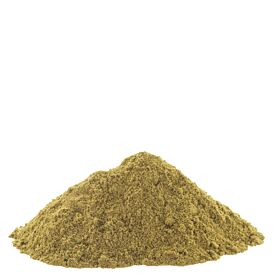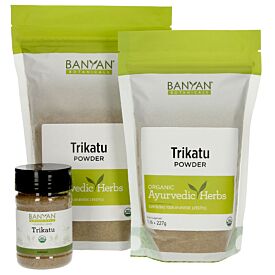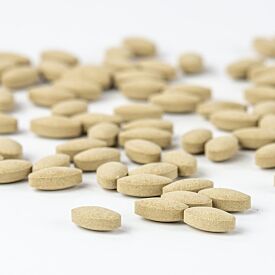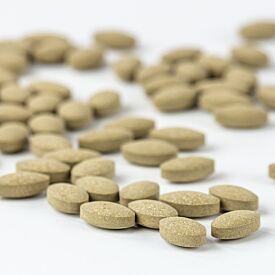Bringing Balance to a Kapha Breath for More Restful Sleep
A 49-year-old female (kapha-pitta prakriti) comes to you wanting help because she continues to feel really sleepy during the daytime, despite some changes in her nightly routine—she turns the T.V. off, she tries to meditate, she puts oil on her head and feet. As an astute practitioner, you tune in to the fact that her partner complains of her very heavy snoring, and she wakes up occasionally feeling like she is gasping for a breath. She is large, particularly around the abdomen, and has a history of high blood pressure. What is the best herb and pranayama combination for this client?
- Punarnava and Anuloma Viloma
- Trikatu and Kapalabhati
- Kutki and Nadi Shodhana
- Ashwagandha and Brahmari
Answer: B
Our goal with this client is to reduce kapha, particularly around the central part of the body, and strengthen the diaphragm ad respiratory muscles. While ashwagandha does calm the nervous system and help promote restful sleep—as does brahmari—this is not the key focus for this client, as it would be in a vata prakriti individual. Punarnava, trikatu, and kutki are all herbs great for kapha, but trikatu most directly addresses the central digestive fire (agni). Supporting the central digestive fire will help kapha locally in the abdomen, as well as feed agni throughout the body. Punarnava will absolutely assist the movement of kapha, and kutki will support a healthy liver, which will support the metabolism of kapha, especially in the circulatory system—but it is always best to start with the core digestive fire first.
Of the pranayamas, kapalabhati is the best choice. (Read more below!)
A complete approach to a client such as this one will include a focus on pranayama and yoga, herbs, and lifestyle changes. A general kapha-balancing diet and lifestyle will be the foundation of this client’s journey back to health and restful sleep.
Pranayama
Since we are working with the diaphragm and good breath (hence, good flow of the life force or prana), pranayama is positively the first thing that comes to mind. Let’s focus on three:
- Kapalabhati. Known as the “glowing skull shining” breath, this pranayama, with an active exhalation from the core, tones the digestive organs and stimulates the digestive fire. It also massages the heart, pelvic organs, and actively works the abdominal muscles and diaphragm. It is energizing, pumping prana throughout the bodily channels so as to clear and revive them.1
- Bhastrika. With an over-exaggerated exhalation, this pranayama removes air from the dead space of the lungs. It helps with metabolism, massages the diaphragm, heart, and thyroid. It forcefully expels kapha and mucus from the head and body and activates the liver and abdominal muscles.
- Anuloma Viloma. By supporting the flow of prana equally through the left and right nostrils, this pranayama brings balance to the body. In a forceful manner, using an ujjayi breath, it clears sinuses, regulates the digestive fire, and supports healthy circulation.
Herbs
Consider these herbs in your protocol:
- Support the central digestive fire. Trikatu, or Kapha Digest, is a powerful combination of herbs to support agni. Alternatively, Ginger liquid extract will also support agni. Take both of these about fifteen minutes before meals.
- If you find more kapha in the lungs and sinuses in addition to general kapha throughout the body, consider Lung Formula, with herbs like pippali, cardamom, tulsi, clove, and cinnamon. This formulation augments the agni of the lung tissue and moves the kapha. Given the close proximity of the lung tissue to the diaphragm, it will also have a positive impact there. Likewise, fast-track tulsi to the lung tissue and throughout the circulatory system with Tulsi liquid extract. Tulsi is not only warming and rejuvenative, but it is also very sattvic (harmonizing).
- Trim Support—with herbs like punarnava, chitrak, guggulu, ginger, and pippali, is a great overall support for moving kapha and toxins out of the entire body. Healthy Kapha is similarly effective with slightly more focus on kapha in the circulatory system and central digestive fire.
- Support sleep imbalances with I Sleep Soundly, starring valerian, bhringaraj, and skullcap.
Lifestyle
Aside from general kapha-balancing lifestyle and diet choices, consider these practical recommendations:2
- Lose weight and exercise! Yoga poses that are fast-paced, activate the core, and done with a strong Ujjayi breath, are ideal, especially if practiced daily.
- Clear kapha from the sinuses with Nasya Oil before going to sleep.
- Do steam inhalations with eucalyptus oil, which has a kapha-pacifying effect on the lung tissue and thoracic cavity.
- Do not eat right before sleep, and ideally eat before sunset so as to minimize kapha in the body and a dampening of the digestive fire throughout the night.
- Avoid snacking. Stick to three meals a day, focusing on lunch as your largest meal (during the pitta time of the day with agni at its strongest!).












